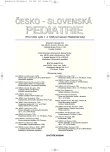Paediatric Prevention in Chronic Kidney Diseases
Authors:
M. Šašinka 1; Ľ. Podracká 2
Authors‘ workplace:
Katedra pediatrie Slovenskej zdravotníckej univerzity, Bratislava
vedúca doc. MUDr. K. Furková, CSc., mim. prof.
1; I. Klinika detí a dorastu LF UPJŠ, Košice
prednostka prof. MUDr. Ľ. Podracká, CSc.
2
Published in:
Čes-slov Pediat 2008; 63 (10): 580-586.
Category:
Review
Overview
The number of chronic kidney diseases (CKD) imminently increases and the open challenge for paediatric nephrologists and primary paediatrician is active screening of the risk factors and effective prevention in these patients. Besides anaemia and disturbances of calcium and phosphorus children with CKD are susceptible for infections, have disturbances of lipids and glycaemia associated with high cardiovascular risk and higher incidence of tumours. In the prevention of the infections is effective vaccination (against influenza, pneumococcus, hepatitis B and in patients with high risk hepatitis A, too), to take care of the skin, the prevention of the oral cavity infections (stomatitis, gingivitis, dents caries), screening of tuberculosis and early effective therapy of hepatitis C. Obligatory part of the prevention of cardiovascular diseases in CKD is management of dyslipidaemia with target LDL level <2.6 mmol/l. If patient has also diabetes is target LDL level <1.8 mmol/l. In the prevention of tumours is important repeated USG screening of the urogenital tract. Complex preventive measures are in tables; their application can substantially improve life quality and long-term surviving in children with CKD.
Key words:
chronic kidney diseases (CKD), immunodeficiency, influenza, hepatitis A, B, C, dyslipidaemia, tumours of uropoetic tract, screening, prevention
Sources
1. United States Renal Data System (online 2007). Annual Report 2007. Chapter 2: ESRD incidence & prevalence. http://www.usrds.org/2007/pdf/02_incid_prev_07.pdf] (dostupné od 30. 1. 2008).
2. Choudhury D, Luna-Salazar C. Preventive health care in chronic kidney disease and end-stage renal disease. Nat. Clin. Pract. Nephrol. 2008; 4(4). www.medscape.com (dostupné od 19. 2. 2008).
3. Šašinka M, Podracká L, Furková K. Chronická renálna insuficiencia u detí. In Dzúrik R, Šašinka M, Mydlík M, Kovács L. Nefrológia. Bratislava: Herba s.r.o., 2004 : 880.
4. Šašinka M, Podracká L. Chronická renálna insuficiencia. In Šašinka M, Šagát T, Kovács L. Pediatria. Bratislava: Herba s.r.o., 2007 : 1450.
5. Naqvi SB, Collins AJ. Infectious complications in chronic kidney disease. Adv. Chronic Kidney Dis. 2006;13 : 199–204.
6. Sarnak MJ, Jaber BL. Mortality caused by sepsis in patients with end-stage renal disease compared with the general population. Kidney Int. 2000;58 : 1758–1764.
7. Sedlacek M, Gemery JM, Remillard BD, et al. Aspirin treatment is associated with a significantly decreased risk of Staphylococcus aureus bacteremia in hemodialysis patients with tunneled catheters. Am. J. Kidney Dis. 2007;49 : 401–408.
8. Kasiske BL, Cangro CB, Hariharan S, et al. The evaluation of renal transplantation candidates: clinical practice guidelines. Am. J. Transplant. 2001;1(Suppl 2): S3–S95.
9. Passalent L, Khan K, Richardson R, et al. Detecting latent tuberculosis infection in hemodialysis patients: a head-to-head comparison of the T-SPOT. TB test, tuberculin skin test, and an expert physician panel. Clin. J. Am. Soc. Nephrol. 2;2007 : 68–73.
10. Hussein MM, Mooij JM, Roujouleh H. Tuberculosis and chronic renal disease. Semin. Dial. 2003;16 : 38–44.
11. Bergman S, et al. Hepatitis C infection is acquired pre-ESRD. Am. J. Kidney Dis. 2005;45 : 684–689.
12. Kamar N, et al. Treatment of hepatitis C virus infection (HCV) after renal transplantation: implications for HCV-positive dialysis patients awaiting a kidney transplant. Transplantation 2006;82 : 853–856.
13. Cases A, Coll E. Dyslipidemia and the progression of renal disease in chronic renal failure patients. Kidney Int. 2005;68(Suppl 99): S87–S93.
14. Krane V, Wanner C. At which stage of chronic kidney disease should dyslipidemia be treated? Nat. Clin. Pract. Nephrol. 2006;2 : 176–177.
15. Mason NA, et al. HMG-coenzyme a reductase inhibitor use is associated with mortality reduction in hemodialysis patients. Am. J. Kidney Dis. 2005;45 : 119–126.
16. Meas T, et al. Elevation of CKP induced by ezetimibe in monotherapy: report on two cases. Diabetes Metab. 2006;32 : 364–366.
17. Oomichi T, et al. Impact of glycemic control on survival of diabetic patients on chronic regular hemodialysis: a 7-year observational study. Diabetes Care 2006;29 : 1496–1500.
18. KDOQI Clinical practice guidelines and clinical practice recommendations for diabetes and chronic kidney disease. Am J Kidney Dis 2007;49(Suppl 2):S12-S154.
19. Cengiz K. Increased incidence of neoplasia in chronic renal failure (20-year experience). Int. Urol. Nephrol. 2002;33 : 121–126.
20. Peces R. Malignancy and chronic renal failure. Saudi J. Kidney Dis. Transpl. 2003;14 : 5–14.
Labels
Neonatology Paediatrics General practitioner for children and adolescentsArticle was published in
Czech-Slovak Pediatrics

2008 Issue 10
- What Effect Can Be Expected from Limosilactobacillus reuteri in Mucositis and Peri-Implantitis?
- The Importance of Limosilactobacillus reuteri in Administration to Diabetics with Gingivitis
Most read in this issue
- Henoch-Schönlein Purpura from the Standpoint of Preventive Corticoid Administration
- Assessment of Clinical Signs of Intracranial Hypertension in Newborns and Infants with Hydrocephalus in Relationship to the Indication of Drainage Procedure
- Heterotopy of Stomach Mucosa – Review of Literature and Our Experience
- Prader-Willi Syndrome in Newborns – Two Case Reports
